This is what happens when Techland goes to the comic book store: we end up talking about what we picked up. This week, Douglas Wolk, Graeme McMillan, Evan Narcisse and Mike Williams discuss You’ll Never Know: Collateral Damage and Action Comics #893.
DOUGLAS: The first volume of You’ll Never Know, Carol Tyler’s projected three-volume series about her father’s experiences in World War II–and all the family history connected to it–was my favorite graphic novel of last year. The new volume, Collateral Damage, is even stronger in a lot of ways. It’s open-ended on both ends, and Tyler has to do a lot of plot-wrangling and cast-explaining and digressing, but there’s a remarkable alchemy in the way she transforms personal and familial tragedy into art–not just communicating terrible things gracefully and universally, but using the events of her story to get across a way of seeing the world.
(More on Techland: The Comic Book Club: Serenity and The Bulletproof Coffin)
The title “You’ll Never Know” had a couple of meanings in the first volume: it’s the Vera Lynn standard, but also suggested her father’s decades of silence about what happened to him. It takes on an additional meaning here: she realizes that, as much effort as she’s put into figuring out what her dad has been shakily remembering, she may not even understand his motivations for bringing it to light again at all. And she gets into her mother’s silence, too, in “The Hannah Story”–the piece about her sister that’s incorporated toward the end of the book, about which I don’t want to say anything for people who haven’t read it yet, except to note that in its original form it made the Comics Journal’s 1999 list of the top 100 comics of the 20th century.
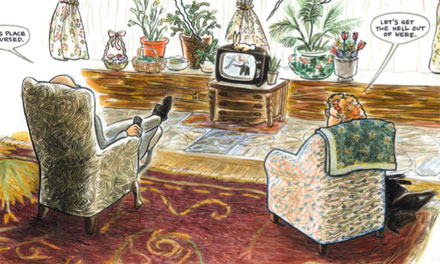
But the thing that keeps drawing me back to the book, and Tyler’s work in general, is her artwork: she’s got a sense of design and decoration, and a feel for color, that I absolutely love, and it makes her complicated, digressive story totally compelling to look at. I just flipped the book open to a random page, and hit a particularly incredible one. It’s a full-page image of her parents, seen from behind, watching TV in their cabin in the Adirondacks–just about the least dramatically interesting subject for a splash page anybody could invent, theoretically–and it’s a stunner: she nails the variety of textures and colors in the room, the sort of things they decorate their home with, the way a television set sucks in all the attention in a room, the beautiful-but-stifling frozen landscape outside the window, the weird pose of a sleeping dog… there’s even a cute little joke it took me a little while to notice: the rabbit on top of the TV set, in lieu of “rabbit ears”!
(Incidentally, did anybody see Tyler’s table in Artists’ Alley at Comic-Con? She actually brought in some flowers, and decorated the table and its surroundings. It was a little oasis in that physically miserable environment. Actually, her story in this volume of how she tried to make her classroom a “zone of sanity” for her first-graders reminded me a bit of that.)
MIKE: It took some work, but I finally started to find this book compelling. By that, I mean it wasn’t until the first war scrapbook section that I was really enjoying myself. I didn’t read volume one, and as a new reader to the series I was thrown into the deep end of the continuity pool. Even with the introductions near the beginning, none of these people meant anything to me. I struggled to connect.
A lot of the barrier was the art. I agree with you, Douglas, that there are some pages that are absolutely gorgeous. Unfortunately, these pages are few and they are rarely to never pages with character interaction. The maps of Europe, the landscapes, the layout of the cabin’s TV room, these are all great–but all too often the side tracks and anecdotes devolve into this notebook-margin look and feel that seems less like a stylistic choice and more like rushed effort. I think it’s a testament to the story that I still wanted to turn pages despite the distractions like the uneven lettering and thin red marker borders.
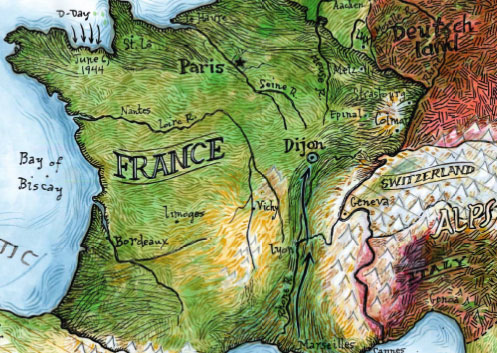
Getting back to the story, I was concerned that this was going to be 100+ pages about a family with standard family problems. The story picks up speed throughout the book. The last twenty pages or so are filled with reveals and shocking twists that lead to a decent cliffhanger. The truth is this family reveals itself to have some standard looking problems, and they really are standard (health issues, taboo conversation topics, divorces, geographically spread out), but some very strong characters, like the father, pull the story along despite itself. I think that Tyler’s strength lies in making these stories, these people, so relatable even if the reader never had a relative in a war, for example, or dealt with severe illness in a parent.
I’ll be tracking down volume one for certain.
GRAEME: I also didn’t read the first volume, and like Mike, I’m going to make sure to fix that now that I’ve read this one. Also like Mike – apparently my refrain this week – I found it hard to get going, because of the abruptness with which this starts, even with the “This is what you missed” recap and character intro at the start. But even as I struggled to work out the relationships and characters, the art really kept me involved. I’ve never really thought about Tyler as an artist whose work I’ve loved before, so much as a writer who also draws, if that makes sense, but her work here is exactly right, weirdly reminiscent of Posey Simmons in places. It also reminds me of Craig Thompson’s work at times, too, but a less self-obsessed Thompson. Or am I alone in that?
DOUGLAS: Interesting. For me, Tyler’s artwork is where her stories “live” (look at how much of the artwork here is symbolic or somehow decorative rather than strictly representational!), and the text kind of fills in the details of fact. I see some resemblances to Thompson, now that you mention it (although it’s worth mentioning that Tyler started publishing comics in 1987, 12 years before Thompson…)–but I also think a lot of both of their artwork’s DNA comes from Justin Green. (Who, if it wasn’t quite made clear by this volume, is “Jud,” the husband who’s run off and left her and their daughter.)
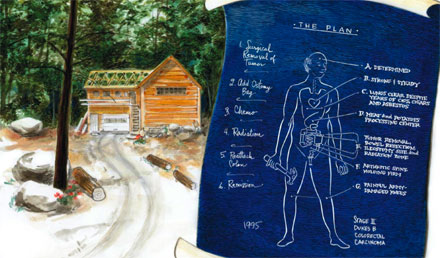
GRAEME: The more I think about it, I may mean that Tyler’s visuals have never seemed particularly attractive or arresting to me before – or, at least, not as much as they do here (although I’d be lying if I said she was a creator I’d been paying a lot of attention to). One of the things I love about what she does here is letting the visuals change to adapt to what the narrative needs of them, which is definitely the hallmark of an artist confident enough in their own talents, but also one who understands the importance of the visuals, something that I don’t think I’d given her nearly enough credit for in the past.
(More on Techland: The Comic Book Club: X-Men, Superman and Parker)
EVAN: You know, that art struck me oddly too. I came down on deciding that I don’t love Tyler’s figurework, but have to recognize that she CAN draw. Her art reminds me, weirdly enough, of Lynda Barry by way of Posy Simmonds. The thing I do love about You’ll Never Know is the lyricism in the artwork. I totally agree with Douglas, that the text is just there to help you keep up.
Storywise, there’s almost too much pathos here. Like Graeme and Doug, I was catching up too. And man, there was a lot of drama in those first few pages. But, as you get into it, it’s clear that it’s not so much her dad’s story as it is Tyler’s vision of her dad’s story. Bubbling behind every panel is the presence of a lot of research, yet Tyler doesn’t hit you over the head with it.
That fireworks sequence really hit me hard. Maybe it was her use of darkness or the way the explosions kind of thematically led into her dad’s scrapbook, but that tenderness did make me choke up.
DOUGLAS: And on we go to the other end of the comics store: Action Comics # 893. Hey, Superman actually shows up! (In a non-speaking role, in a flashback, from behind, for one panel, in the backup story.) Somebody alert JMS!
I’m really fond of what Cornell’s been doing on this series: for a comic that’s been effectively kneecapped by having its star of 70 years’ standing kicked out for the last couple of years, this is one heck of an entertaining series right now. If I’m not mistaken, the idea of Grodd gaining people’s knowledge by eating their brains, planarian worm/Swamp Thing-style, is not something we’ve ever seen before in comics in which he’s appeared, but what the hell, he’s a super-strong psychic talking gorilla, I’m willing to buy it. Especially because the story involves Grodd’s “biggest combat spoon.” I also love the idea that the next issue will apparently involve Lex negotiating directly with Death. And I’m starting to suspect that the whole story is Lex’s self-aggrandizing fantasy version of something we’re not seeing, too.
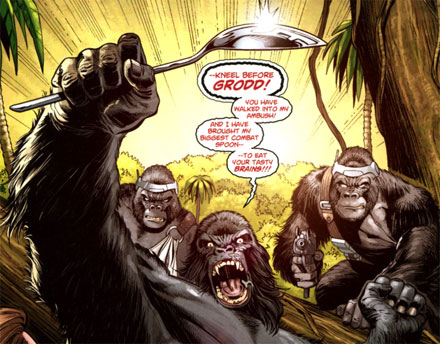
MIKE: I think I’ve said something along these lines before in The Club, but writing for characters that are geniuses (let alone 12th level intellects) is a slippery slope. This was a fight between two genius-level characters (Grodd’s a genius in addition to being super-strong and psychic, right?) and it never felt like one. It came down to a ruse, and while it was certainly a fun ride, it never felt like Luthor at the wheel. I guess the fun ride part is all that matters. You’re right, Douglas, it’s a giant talking gorilla.
(More on Techland: The Comic Book Club: “The Last Phantom” and “Set to Sea”)
I just really want to identify with Lex. During Blackest Night, when he got his power ring and he finally admitted that he wanted to be Superman, he became my favorite character in the DC Universe. Here was a guy acting on such an instinctually human level. Who doesn’t want the power of flight? I hope he finds what he’s looking for. As it is, he’s become more Wile E. Coyote than evil genius.
GRAEME: I agree, to an extent, but I think Cornell addresses that in the story itself. This isn’t “regular” Lex, but a Lex who’s off because of his post-Orange Ring need that’s making him desperate and rash, instead of his usual manipulative genius self. It might be a weak excuse to write the character Cornell wants, but it’s one I’m willing to buy into, because each issue is enjoyably fresh and free of the angst found elsewhere in the DCU these days (plus, I think Robot Lois is my new comic book crush). What I’m finding, the more this run goes on, though, is that as much as I enjoy each individual issue, the storyline as a whole feels really piecemeal and choppy. I get that each issue has a new villain, and stands alone to an extent, but the whole quest seems to be really confusing in terms of how it goes from one location to the next between issues. Maybe I’m wrong, though; I might just need to sit down and re-read all of the issues together.
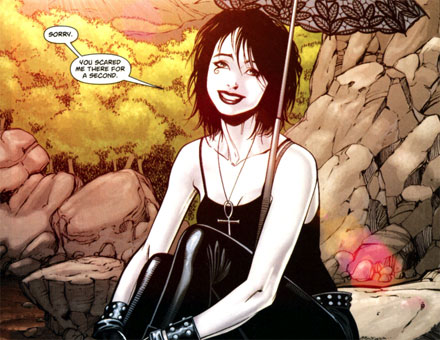
Also: Sean Chen’s work was nice enough – especially on the sequence where Grodd tries to eat Lois – but I missed Pete Woods this time out.
DOUGLAS: Yeah, I missed Pete Woods too: his character acting is subtle, but it really kept the first few installments moving. Chen’s work here is functional, but also pretty generic–I don’t think I realized how much Woods added to the overall tone of this story until he ducked out for a spell.
EVAN: You know, the recent trend of back-ups has kind of rankled me. I’ve felt like they’ve been used as stopgaps for creators who can’t fulfill their deliverables (ugh, I know) or as half-assed tryouts. But, to me, the Jimmy Olsen back-up actually outclassed the lead story. That’s impressive, given how good Cornell’s run has been. The trick that Spencer nails is that this Jimmy feels of the moment but not like any of the story is trying too hard. And as the gaming contributor here, let me give props for good video game references in a comic book.
(More on Techland: The Comic Book Club: Wonder Woman and Action Comics)
As for the main story, I really like latter-day Grodd. Johns’ re-invention of him in his Flash run was a little horrific, so it’s nice to see Cornell’s take on the big ape be leavened by a little humor.
Oh, and that panel where Lois-bot watches the other android get de-activated? That’s what we call foreshadowing, kids.
DOUGLAS: I don’t think I’d actually read anything by Nick Spencer before the Jimmy Olsen backup here (although now I’m dying to read Morning Glories, any of y’all got something to say about it?), but I liked it a lot. Spencer’s got a lot of “newish comics writer” tics–chiefly cramming Claremontian word-counts into every panel and stretching for topical gags–but this has a lot of nutty energy about it, and a clever cliffhanger. Mostly, I’m happy that this Jimmy isn’t the hard-boiled but callow glyph we’ve seen in the past few years; the interpretation here owes a bit to All-Star Superman, I think–the guy who’s a flamboyant jerk in a lot of ways, but who’s also Superman’s best friend because he’s brave, funny, and (most importantly) totally unafraid of personal transformation.
MIKE: I really enjoyed it too. Spencer does a good job of poking fun at the Superman signal watch. That’s a bit of Superman history I could live without, especially with the constant ratcheting up of Supe’s power levels. (Did anyone watch the DCU video game trailer where he hears Wonder Woman cry out on Earth while he’s floating far off in space? C’mon.) Spencer’s Morning Glories isn’t quite as tightly packed, but it is high on mystery. That series counts LOST as its main influence and it shows.
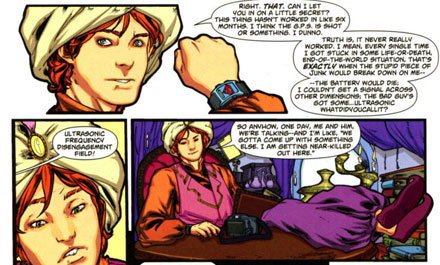
There’s no doubt that Jimmy is going to save Metropolis (Earth?) from the invading alien armada. The question will be how Spencer will pull it off. I’m going to call that Jimmy will dress up in some kind of uniform/costume and either bluff them or go pure bravado and use heavy-handed diplomacy. All in the name of getting Chloe back.
GRAEME: Yeah, I really enjoyed this one as well. It’s got a nice mix of fun – I almost said innocent fun, but that’s not entirely right, because there’s a certain knowingness even to the Genie sequence that starts the whole thing off – and meta-commentary on the state of Jimmy as a character. I get the Morrison/All Star Superman influence, but there’s also some work here that’s very reminiscent of what Joe Casey was trying to do with the character way back when he was writing Adventures of Superman, way back in… 2001, perhaps? 2002? I like that there’s no doubt that Jimmy will save the world, either in the reader’s mind or the character’s; it’s all about the lengths he’ll go to to do so, which shifts expectations in a nice direction. Here’s hoping later episodes live up to this one.

